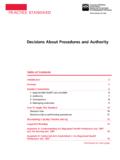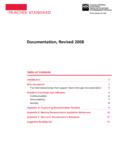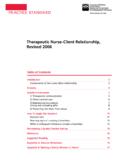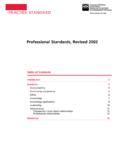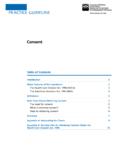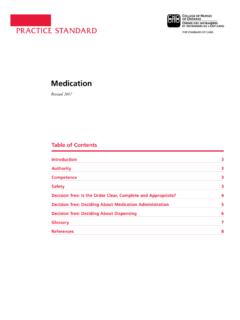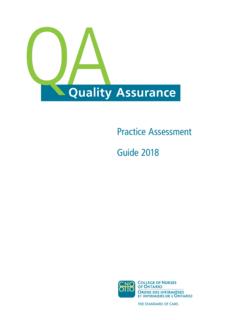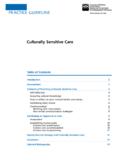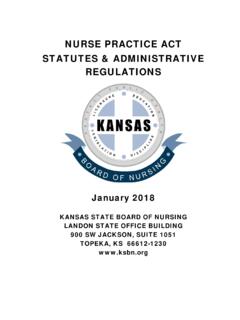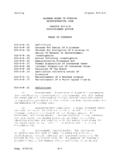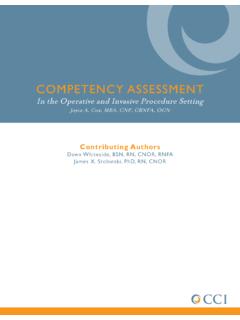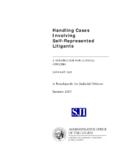Transcription of PRACTICE GIDELINE Authorizing Mechanisms - CNO
1 PRACTICE GUIDELINET able of Contents Introduction 3 Legislation Governing nursing PRACTICE 3 Scope of PRACTICE and controlled acts 3 Controlled acts authorized to nursing 4 Controlled acts authorized to NPs 4 Authorizing Mechanisms 4 Orders 4 Direct orders 5 Directives 5 InitiationConditions for initiating controlled acts 5 Restrictions on initiating controlled acts 5 Delegation 6 Who can delegate, which acts can be delegated and who can accept delegation 6 Restrictions on delegating 7 Sub-delegation 7 Delegation and orders 7 Delegation by nurses 7 Accepting delegation 8 Documenting the particulars of delegation 10 Authorizing MechanismsRevised 2018 Continued on next pageTable of Contents continuedAuthorizing Mechanisms Pub.
2 No. 41075 ISBN 978-1-77116-098-8 Copyright College of Nurses of Ontario, published in October 2007. Updated in May 2008, June 2009, July 2009 (ISBN 1-897308-33-7). Updated November 2011 for Bill 179 changes. Updated 2013 for Delegation Regulation. Revised January 1, 2014 for Dispensing. Updated May 2015 removed footnote for medication update (ISBN 978-1-77116-034-6). Revised January 2018 for Controlled Act of or for-profit redistribution of this document in part or in whole is prohibited except with the written consent of CNO. This document may be reproduced in part or in whole for personal or educational use without permission, provided that: Due diligence is exercised in ensuring the accuracy of the materials reproduced; CNO is identified as the source; and The reproduction is not represented as an official version of the materials reproduced, nor as having been made in affiliation with, or with the endorsement of, copies of this booklet may be obtained by contacting CNO s Customer Service Centre at 416 928-0900 or toll-free in Cannada at 1 800 of Nurses of Ontario 101 Davenport Rd.
3 Toronto, ON M5R fascicule existe en fran ais sous le titre : Les m canismes d autorisation, n 51075 VISION Leading in regulatory excellenceMISSION Regulating nursing in the public interestTools for Delegating, Accepting Delegation and Developing Directives 10 Assigning, Supervising or Teaching a Procedure 10 Assigning a procedure 10 Supervising a procedure 10 Teaching a procedure 10 Decision Tree #1: Deciding to Perform a Procedure 11 Appendix A: procedures That RNs and RPNs May Initiate According to the nursing Act, 1991 12 Decision Tree #2: Assigning, Supervising or Teaching a Procedure 13 PRACTICE GUIDELINE3 College of Nurses of Ontario PRACTICE Guideline: Authorizing MechanismsIntroductionAn Authorizing mechanism an order, initiation, directive or delegation is a means specified in legislation, or described in a PRACTICE standard or guideline, through which nurses1 obtain the authority to perform a procedure or make the decision to perform a procedure.
4 The College of Nurses of Ontario (the College) is responsible for providing clear, concise and up-to-date guidance to nurses. As self-regulating professionals, nurses are responsible for practising in accordance with the PRACTICE documents that the College publishes and with relevant legislation. Understanding legislative responsibilities is critical for nurses to make decisions about how to perform procedures safely. It is also important to ensure that nursing PRACTICE is consistent with the College s PRACTICE Mechanisms are complex concepts that are covered in a number of College documents. To create this PRACTICE guideline, the College has consolidated and condensed information in its Decisions About procedures and Authority PRACTICE standard and Working With Unregulated Care Providers PRACTICE PRACTICE guideline provides nurses with expectations about delegation.
5 It is intended to help nurses provide efficient, timely access to health care by helping them understand Authorizing Mechanisms , as well as their accountabilities when using them. However, nurses should still consult Decisions About procedures and Authority for more information on Authorizing Governing nursing PracticeThe Regulated Health Professions Act, 1991 (R HPA) sets out a framework for Ontario s regulated health It provides a common set of rules of procedure for the colleges and is linked to each profession-specific act, including the nursing Act, 1991. The RHPA framework sets out two elements: a scope of PRACTICE statement, and a series of controlled or authorized acts for each profession. Under these acts, nurses are given the authority to perform controlled acts and provide client care.
6 There are other acts that govern the PRACTICE of health care, including nursing , in Ontario. Each sets out requirements for PRACTICE in the settings and circumstances to which it applies. They include (but are not limited to) the: Public Hospitals Act; Healing Arts Radiation Protection Act; Laboratory and Specimen Collection Centre Licensing Act; Mental Health Act; and Long-Term Care Homes Act, 20074 Scope of PRACTICE and controlled actsThe scope of PRACTICE statement for nursing is as follows: The PRACTICE of nursing is the promotion of health and the assessment of, the provision of, care for, and the treatment of, health conditions by supportive, preventive, therapeutic, palliative and rehabilitative means in order to attain or maintain optimal acts are defined as acts that could cause harm if performed by those who do not have the knowledge, skill and judgment to perform A regulated health professional is authorized to perform 1 Nurse refers to a Registered Practical Nurse (RPN), Registered Nurse (RN) or Nurse Practitioner (NP).
7 2 These documents are available on the College s website at For more information, refer to the College s RHPA: Scope of PRACTICE , Controlled Acts Model document at For more information on these and other acts, visit the Ontario Statutes and Legislation website at From the nursing Act, 1991. 6 The RHPA includes exceptions that permit individuals who are not members of regulated health professions to perform controlled acts in defined GUIDELINE4 College of Nurses of Ontario PRACTICE Guideline: Authorizing Mechanismsa portion or all of the specific controlled acts that are appropriate for her/his profession s scope of PRACTICE . Because some scopes of PRACTICE overlap, some professionals are authorized to perform the same, or parts of the same, controlled acts authorized to nursingPerforming controlled acts represents only a small portion of nursing PRACTICE .
8 It is important to note that: controlled acts are not the only procedures that can cause harm; having the authority to perform a procedure does not automatically mean it is appropriate to do so; and each nurse is accountable for her/his decisions and nurses are authorized to perform the following controlled acts:1. Performing a prescribed procedure below the dermis or a mucous Administering a substance by injection or Putting an instrument, hand or finger i. beyond the external ear canal,ii. beyond the point in the nasal passages where they normally narrow,iii. beyond the larynx,iv. beyond the opening of the urethra,v. beyond the labia majora,vi. beyond the anal verge, orvii. into an artificial opening into the Dispensing a drug. 5. Treating, by means of psychotherapy technique, delivered through a therapeutic relationship, an individual s serious disorder of thought, cognition, mood, emotional regulation, perception or memory that may seriously impair the individual s judgement, insight, behaviour, communication or social Registered Nurse (RN) or Registered Practical Nurse (RPN) is authorized to perform these controlled acts under the following two conditions: if initiated in accordance with the conditions identified in the regulation;7 or if ordered by a physician, dentist, chiropodist, midwife or Nurse Practitioner (NP).
9 An RN or RPN will not require an order for the controlled act of psychotherapy during a two year exemption period (Dec. 30, 2017 to Dec. 31, 2019).Controlled acts authorized to NPsNPs can perform the following controlled acts:1. Communicating to a client or client s representative a diagnosis made by the NP identifying as the cause of a client s symptoms, a disease or Performing a procedure below the dermis or a mucous Putting an instrument, hand or finger,i. beyond the external ear canalii. beyond the point in the nasal passages where they normally narrowiii. beyond the larynxiv. beyond the opening of the urethrav. beyond the labia majoravi. beyond the anal verge, orvii. into an artificial opening of the Applying or ordering the application of a prescribed form of Setting or casting a fracture of a bone or dislocation of a Adminstering a substance by injection or inhalation, in accordance with the regulation, or when it has been ordered by another health care professional who is authorized to order the Prescribing, dispensing, selling and compounding a drug in accordance with the Treating, by means of psychotherapy technique, delivered through a therapeutic relationship, an individual s serious disorder of thought, cognition, mood, emotional regulation, perception or memory that may seriously impair the individual s judgement, insight, behaviour.
10 Communication or social MechanismsAuthorizing Mechanisms provide nurses with the authority to implement treatment plans and 7 See Conditions for Initiating Controlled Acts on page GUIDELINE5 College of Nurses of Ontario PRACTICE Guideline: Authorizing Mechanismsprotocols. Choosing the appropriate Authorizing mechanism depends on the nurse s category or class, role and PRACTICE setting. OrdersAn order is a prescription for a procedure, treatment, drug or An order is required when: a procedure falls within one of the controlled acts authorized to nursing , when a nurse has not initiated the act;9 a procedure does not fall within any controlled act, but is part of a medical plan of care; a procedure falls within one of the controlled acts not authorized to nursing ; or a procedure/treatment/intervention is not included in the RHPA, but is included in another piece of An RN or RPN will not require an order for the controlled act of psychotherapy during a two year exemption period (Dec.)
